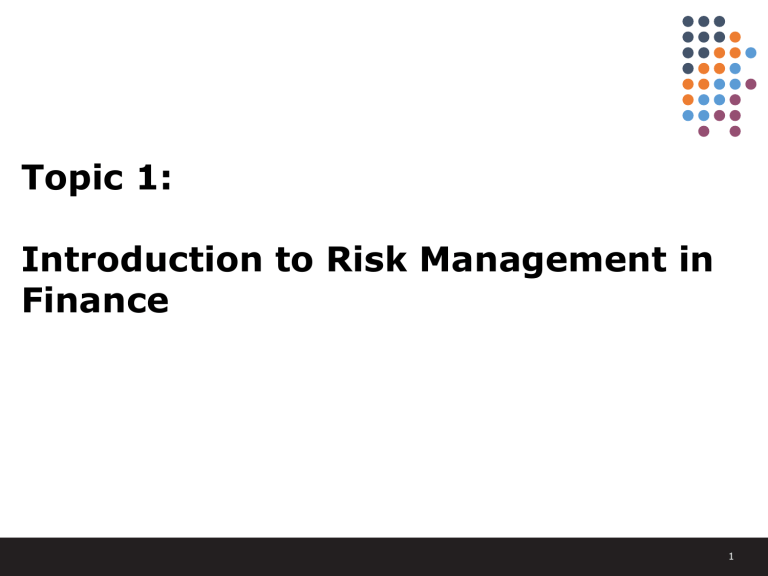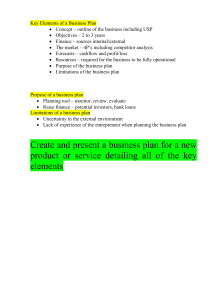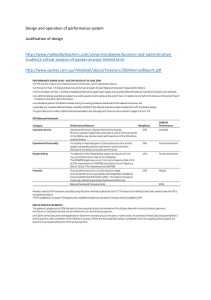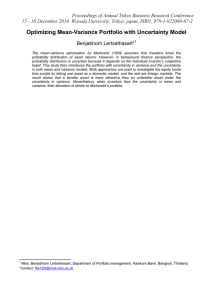
Topic 1: Introduction to Risk Management in Finance 1 1.1 What is Risk? • In the Concise Oxford English Dictionary: – Risk is hazard dangerous to your health, safety, wealth, plan or reputation. – A chance of bad consequences – Loss or exposure to mischance • McNeil et al. (2005): “Risk is any event or action that may adversely affect (negative impact) an organization’s ability to achieve its objectives and execute its strategies (how to increase sales/profit)”. • Anyway, no single one-sentence definition captures all aspects of risk. • Risk =Chance of Loss ⇒ Randomness (no direction) / Uncertainty not sure 2 1.1 What is Risk? (cont’d) • Distinguishing between “Uncertainty” and “Risk” – Uncertainty exists whenever one does not know for sure what will occur in the future. (do not know what happen in future) – Risk is the uncertainty that matters if it affects people's welfare. (life/ monetary) • Thus, uncertainty is a necessary but not a sufficient condition for risk. • Every risky situation is uncertainty, but there can be uncertainty without risk (no change in profit). – For example, the uncertainties happening in a project’s daily operations are not a risk, as long as the uncertainties are not developing into a risk that affects the project profits. 3 1.1 What is Risk? (cont’d) • In many risky situations, the possible outcomes can be classified either as losses or gains in a simple and direct way. • For example, suppose that you invest in the stock market. If the value of your stock portfolio goes down, it is a loss; and if it goes up, it is a gain. • The issue is people normally consider the "downside" possibility of losses to be the risk, not the "upside" potential for a gain (investors respond to risk differently). • But, there are some situations in which there is no obvious downside or upside in the short run, if the upside gain is not substantial and long enough, we can’t say it is definite upside risk. 4 1.1 What is Risk? (cont’d) Economists use three categories to describe how investors respond to risk: • Risk averse is the attitude toward risk in which investors would require an increased return as compensation for an increase in risk. • Risk neutral is the attitude toward risk in which investors choose the investment with the higher return regardless of its risk. • Risk seeking is the attitude toward risk in which investors prefer investments with greater risk even if they have lower expected returns. 5 1.1 What is Risk? (cont’d) • Risk aversion is also a measure of willingness to pay to reduce one's exposure to risk. • In evaluating trade-offs between the costs and benefits of reducing risk, risk averse people prefer lower-risk alternatives for the same cost or expected rate of return. • For example, if you are generally willing to accept a lower expected rate of return on an investment because it offers a more predictable rate of return (i.e. less risk), you are risk averse. 6 1.2 Risk Exposure • If you face a particular type of risk because of your job, the nature of your business, or your pattern of consumption, you are said to have a particular risk exposure. • For example, – If you are a farmer, you are exposed both to the risk of a crop failure[operating risk because crop is part of the supply chain of the farmer] and to the risk of a decline in the price at which you can sell your crops[commodity price risk]. – If your business significantly involves imports or exports of goods, you are exposed to the risk of an adverse change in currency exchange rates. [currency risk / foreign exchange risk] – If you own a house, you are exposed to the risks of fire, theft, storm damage, earthquake damage, as well as the risk of a decline in its market value. [market risk] 7 1.2 Risk Exposure (cont’d) • On one hand, a purchase or sale of a particular asset may be risk increasing, and on the other hand, may be risk reducing. • For example, if a farmer with wheat ready to be harvested enters a contract to sell wheat at a fixed price in the future, the contract is risk reducing. (The farmer is a hedger) • But, if a speculator who has no wheat to sell, entering into that same contract to speculate that wheat prices will fall, the contract is risk increasing. • This is because the speculator gets profit only when the market price at the contract delivery date is below the future’s contractual, fixed price (i.e. the speculator can buy at low market price and sell high with the contract). 8 1.2 Risk Exposure (cont’d) • Speculators (risk seeking) are defined as investors who take positions that increase their risk exposure to certain risks in the hope of increasing their wealth. • In contrast, hedgers (risk adverse) take positions to reduce their risk exposures. • The same person or trader in the stock market can be a speculator on some risk exposures and a hedger on others. 9 1.3 Common Risks Faced by Individuals Five common major categories of risk exposures for individuals: 1) Sickness, disability, and death (purchase health and life insurance) [nonfinancial risk] – Unexpected sickness or accidental injuries can impose large costs on people because of the need for treatment and care and loss of income caused by inability to work. 2) Unemployment risk (savings, unemployment insurance) – This is the risk of losing one's job. 3) Consumer-durable asset risk (purchase car insurance, fire insurance) – This is the risk of loss arising from ownership of a house, car or other consumer-durable assets. Losses can occur due to hazards such as fire or theft, or due to obsolescence arising from technological change. 10 1.3 Common Risks Faced by Individuals (cont’d) 4) Liability risk / legal risk(purchase car insurance) – This is the risk that others will have a financial claim against you because they suffer a loss for which you can be held responsible. – For example, you cause a car accident through reckless driving and are required to cover the cost to others of personal injury and property damage. – If you are a guarantee, you are responsible for the financial claim, hence, facing liability risk. 5) Financial-asset risk (diversification, options, futures) – This is the risk arising from holding different kinds of financial assets such as equities or fixed-income securities that denominated in one or more currencies. – The underlying sources of financial-asset risk are the uncertainties faced by the firms, governments, or other economic organizations that have issued these securities. 11 1.4 Risks Faced by Firms • Business risks of the firm are borne by its stakeholders (including shareholders, creditors, customers, suppliers, employees and government). • The financial system in the market can be used to transfer risks faced by firms to other parties. Specialized financial firms such as insurance companies perform the service of pooling and transferring risks (not to reduce the risks). • Ultimately, however, all risks faced by firms are borne by the people (as in 2008 world financial crisis). [this can happened if the counterparty do not fulfil their commitment] 12 1.5 Risk Management Process • Risk Management Process: – The process of formulating the benefit and cost trade-off of risk reduction, and deciding on the course of action to take for managing the risk (including the decision of taking no action at all). • By definition, risk-management decisions are made under conditions of uncertainty, and therefore multiple outcomes are possible. • After the fact, only one of these outcomes will occur. 13 1.5 Risk Management Process (cont’d) • It is difficult in practice to distinguish between the skill and luck of a decision maker. • Neither recriminations nor congratulations for a decision seem warranted, when such action are based on information not available at the time the decision was made. [not at the time the decision’s outcome is produce] [Ex: if a manager compare marginal cost and benefit and make a decision, we say that this manager made a rational decision even the decision will not necessarily produce positive outcome, but as long as the decision is made after considering all aspects, it is a rational decision] • Thus, the appropriateness of a risk-management decision should be judged, in the light of the information availability at the time the decision is made. 14 1.5 Risk Management Process (cont’d) The risk management process can be broken down into five steps: 1. Risk identification – Risk identification consists of figuring out what the most important risk exposures are for the unit of analysis, be it a household, a firm or some other entity. 2. Risk assessment – Risk assessment is the quantification of the costs associated with the risks that have been identified in the first step of risk management. 15 1.5 Risk Management Process (cont’d) 3. Selection of risk-management techniques. – There are four basic techniques available for reducing risk: • Risk avoidance - A conscious decision not to be exposed to a particular risk. • Loss prevention and control - Actions taken to reduce the likelihood or the severity of losses (impact). • Risk retention - Absorbing the risk and covering losses out of one's own resources. • Risk transfer - Transferring the risk to others. [got three types of risk transfer techniques] 16 1.5 Risk Management Process (cont’d) 4. Implementation – Following a decision about how to handle the risks identified, one must implement the techniques selected. – The underlying principle in this step of the risk-management process is to minimize the costs of implementation. 5. Review – Risk management is a dynamic feedback process in which decisions are periodically reviewed and revised. – As time passes and circumstances change, new exposures may arise, information about the likelihood and severity of risks may become more readily available, and techniques for managing them may become less costly. 17 1.6 Three Dimensions[techniques] of Risk Transfer 1) Hedging – One hedges a risk when the action taken to reduce one's exposure to a loss, also causes one to give up of the possibility of a profit. [gain some part of certainty profit while giving up potential gain] – For example, farmers who sell their future crops before the harvest at a fixed price to eliminate the risk of a low price at harvest time, also give up the possibility of profiting from high prices at harvest time. They are hedging their exposure to the price risk of their crops. 2) Insuring – Insuring means paying a premium (for example, the price paid for the insurance) to avoid losses and retain the potential for gain. [only claim insurance when we incur loss] – For example, by buying insurance, you substitute a sure loss (the premium you pay for the policy) for the possibility of a larger loss if you do not insure. 18 1.6 Three Dimensions of Risk Transfer (cont’d) • The fundamental difference between insuring and hedging: – When you hedge, you eliminate the risk of loss by giving up the potential for gain. – When you insure, you pay a premium to eliminate the risk of loss, and retain the potential for gain. 3) Diversifying – Diversifying means holding similar amounts of many risky assets instead of concentrating all of your investment in only one. “Do not put all eggs in a basket” – Diversification thereby reduces your exposure to the risk of any single asset (non-systematic risk). 19 1.7 Risk Management “in Finance” • Financial Risk Management is the process by which the financial risks are identified, assessed, measured and managed in order to create economic value (purpose). • Some risks can be measured reasonably well. For those, risk can be quantified using statistical tools to generate a probability distribution of profits and losses. • Some other risks are not applicable to formal measurement but are nonetheless important. • The function of the risk manager is to evaluate financial risks using both quantitative tools and judgment (qualitative tools). 20 1.8 A Brief History of Financial Risk Management 1) Academic innovation in the 20th century • Markowitz (1952): Theory of portfolio selection; Desirability of an investment was decided upon a risk-return diagram. – An efficient frontier determined the optimal return for a given risk level (x-axis: standard deviation; y-axis: expected return). (for a given same level of risk, choose the best return portfolio; for a given same level of return, choose the lower risk portfolio) • Capital Asset Pricing Model (CAPM) developed in the early 1960s by William Sharpe, Jack Treynor, John Lintner and Jan Mossin. – Expected asset return and systematic (market) risk 21 1) Academic innovation in the 20th century • Late 20th century: Theory of valuation for derivatives – Black and Scholes (1973): Black–Scholes–Merton formula for the price of a European call option (hedging risk of financial asset) (Scholes and Merton received Nobel Prize in 1997) Fischer Black Myron Scholes Robert Merton 22 2) Disasters of the 1990s 1995 Barings Bank ruin • Growing volume of derivatives in banks’ trading books (which often not appearing as assets or liabilities in the bank’s balance sheet do not have proper record). • 1995 Barings Bank’s operational risk loss. – Straddle position on the Nikkei and Kobe earthquake had incurred a total loss of $1.3 billion 23 3) 1996–2000: Dot-com bubble • Technology-dominated Nasdaq index climbed from around 1000 to around 5400. • Many firms that contributed to this rise belonged to the internet sector. • Within one year, the Nasdaq fell by 50%. 24 4) The World Financial Crisis of 2008 • US house prices began to decline in 2006 and 2007. • Subprime mortgage holders (loan borrowers) having difficulties in refinancing their loans due to higher interest rates had defaulted on their payments to banks. • In 2007, this led to a rapid reassessment of the riskiness of securitization and losses in the value of the Collateralized Debt Obligation (CDOs). • Banks were forced into write downs the value of these assets on their balance sheets. 25 Securitization and CDOs - Destructive financial innovation in the century • An asset-backed security (ABS) is a security created from the cash flows of underlying financial assets such as mortgage loans, bonds, credit card receivables, auto loans and aircraft leases. [financial security backed by the income-generating asset] • A particular type of ABS is called Collateralized Debt Obligation (CDO). It is a financial tool that banks use to repackage individual mortgage and loan into a product and sold to investors in the secondary market. Many mortgage loans were given to borrowers with low credit ratings (subprime mortgage borrowers). CDO issuance volume by 2008 was around $3 trillion. • Credit Default Swaps (CDS) is a type of insurance protection against CDO’s default used by investors to speculate on the credit risk. CDS was issued with huge volume around $30 trillion. [usually sold by insurance companies(AIG)] 26 27 28 The Financial Crisis of 2008 (cont'd) • World financial crisis in 2008 is the most serious financial crisis since 1920s and it had caused some of the big financial companies collapsed. • Bear Stearns collapsed in March 2008 and it was sold to JP Morgan Chase. • Lehman Brothers filed for bankruptcy in September 2008 which had caused worldwide panic, markets tumbled, liquidity vanished and many banks nearly collapse. 29 The Financial Crisis of 2008 (cont'd) • AIG (who offer insurance for the default risk in the securitized products by selling CDS protection) got into difficulty when many of the underlying securities defaulted in 2008. • AIG called for an emergency loan of $85 billion from the Federal Reserve Bank of New York. • Governments had to bail out some companies by injecting capital, or acquiring their distressed assets. • US-TARP (Troubled Asset Relief Program) was executed. 30 The Financial Crisis of 2008 (cont'd) 31 Costs of the Financial Crisis 2008 32 Evolution of Global Financial Crisis: Mid 2007- 2010 33 The Financial Crisis of 2008 (cont'd) - Failure of Asset Pricing Models? • Mathematicians/financial engineers were also blamed due to the failure of pricing models used to design the complex securitized products. • Some experts criticise the failure of pricing models are caused by the formula of “Gauss copula model” which its application to credit risk was attributed to David Li. – Read “Recipe for disaster: the formula that killed Wall Street”. https://www.wired.com/2009/02/wp-quant/ • Mathematicians had also warned about securitization. Political short-sightedness, the greed of market participants and the slow reaction of regulators had all contributed to the financial crisis. 34 5) Recent developments and concerns Algorithms Trading Errors • High Frequency Trading (HFT) has raised concerns among the regulators. • The high frequency trades are executed by computer (algorithms) in fractions of a second (no testing), and normally the computer centres are build near stock markets for faster trading. • Algorithms trading error events was triggered: 1) Flash Crash of 06-May, 2010 wiped off trillions of dollars in equity. 2) Knight Capital Group lost $460 million due to trading errors on 01-August, 2012. 35 1.9 Road to Regulation – Basel Accords • Systematic risk (or undiversifiable-risk) of the collapse of the entire financial system due to the propagation of financial stress through a network of participants. The networks are complex. • Besides banks and insurance companies, the financial system contains largely unregulated hedge funds and structured investment vehicles (for example, the “shadow banking system”). • Regulation in bank risk management is to ensure that financial institutions have enough capital to remain solvent.[absorb loss, this technique is called risk retention technique] 36 1.9 The Road to Regulation – Basel Accords (cont’d) • Basel Committee of Banking Supervision (BCBS)[Basel Standard] - Committee established by the Central-Bank Governors of the Group of Ten (G10) in 1974. • Basel Accords drafted by BCBS is the worldwide regulation for bank risk management. • The Basel Committee does not have legal force, but it formulates standards, best practices and guidelines. 37 1.10 Why manage financial risk? - A societal view • Society relies on the stability of the banking and insurance system for optimal consumption and resource allocation of individuals. • The reduction of systemic risk has become an important focus of banking regulation (from which Basel Accords) since the 2007–2009 crisis. • Most would agree that the protection of customers and the promotion of financial stability are vital. • But, it is not always clear whether the two aims are well aligned (for example, it might be good to let a company go bankrupt to teach others a lesson). • Considering some systematically important firms as “too big to fail” creates a moral hazard (which actually should be avoided), because the firm’s management board may take more risk knowing that it would be bailed out in a crisis. 38 1.10 Why manage financial risk? - A shareholder’s view • Individual investors are typically risk averse and they should therefore manage the risk in their portfolios. • But it is not clear whether the risk management at the corporate level (e.g. hedging a foreign-currency exposure or holding a certain amount of risk capital) can increase the value of a corporation and thus enhance shareholder value. [but need to beware of the agency theory: incentive of managers may be different with shareholders’] • The rationale behind is simple: If investors have access to perfect capital markets, they can incorporate risk management via their own trading and diversification. But in real, it is seem impossible. 39 Quotes on Pessimistic and Optimistic.. 40 Comic on Pessimistic and Optimistic.. 41 The End 42





